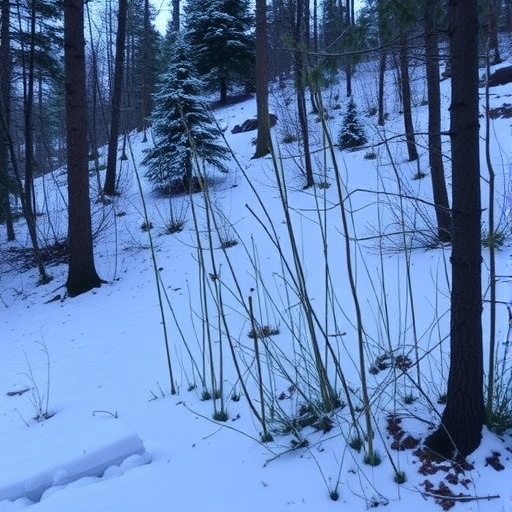In a groundbreaking study recently published in BMC Genomics, researchers have unveiled crucial insights into the molecular mechanisms governing the overwintering strategies of the Histia rhodope larva. This research, spearheaded by Yang et al., takes a deeper look into how temperature and seasonal changes influence the gene expression profiles of this unique species. The findings not only expand upon our understanding of entomological adaptation but also highlight the complex interplay between environmental factors and genetic expressions in cold-weather survival.
Overwintering is a critical phase in the life cycle of many insect species, allowing them to endure the harsh conditions of winter. The Histia rhodope, commonly known as the Rhodope butterfly, exhibits remarkable resilience during these frigid months. By utilizing gene co-expression network analysis, the research team uncovered genes that play pivotal roles in the larval overwintering mechanisms. This innovative approach allowed for the identification of gene interactions that drive adaptive responses to cold stress, revealing a sophisticated biological network that has likely evolved over generations.
One of the standout discoveries of the study was the identification of several key genes linked to the synthesis of antifreeze proteins. These proteins are essential in preventing ice crystallization within the cellular structures of the larva, a crucial factor that allows them to survive subzero temperatures. By analyzing the gene expressions in larvae subjected to varying thermal conditions, the team observed significant shifts in antifreeze protein gene expressions, underscoring the adaptability of Histia rhodope in response to environmental stressors.
The researchers took a multifaceted approach to their analysis. By integrating transcriptomic data with environmental temperature records, they painted a holistic picture of how climate factors influence genetic adaptation. The combination of genomic technologies and computational biology allowed them to model the interactions between different genes, providing insights into how these systems respond to cold stress. The study positions the Histia rhodope as an important model for understanding insect resilience in the face of climate change.
Moreover, the implications of this research reach beyond the butterfly itself. As climate change alters ecosystems and the seasonal variances that insects rely upon for survival, understanding the genetic foundations that enable survival becomes increasingly critical. The findings could inform conservation strategies for other species facing similar threats, illustrating how intricate genetic networks might offer pathways for adaptation.
Beyond just antifreeze proteins, the research illuminated pathways involving heat shock proteins and other stress-response genes. These proteins serve as biological protectors, ensuring that cellular functions remain intact even under extreme conditions. The researchers found that certain genes associated with these proteins were upregulated in larvae during colder months. This highlights a complex molecular ballet that allows insects to employ multiple strategies for survival, all orchestrated at the genetic level.
The implications of Yang et al.’s work extend to agriculture and pest management. As farmers face the challenges of pests adapting to changing climates, understanding the underlying genetic mechanisms can lead to more effective management strategies. Insights into which genes facilitate overwintering may enable the development of targeted interventions that disrupt these processes, thereby providing farmers with tools to combat pest populations before they can proliferate each spring.
In addition to practical applications, the study opens the door to further inquiries into other insect species. It lays the foundation for comparative studies on overwintering strategies across diverse taxa. As researchers continue to explore the genetic basis of cold tolerance, they may uncover universal principles applicable to a wide range of organisms, not just the Histia rhodope.
Another interesting facet of the gene co-expression network analysis was the potential identification of regulatory elements that govern gene expression. Understanding transcription factors and other regulatory proteins involved in the overwintering process could unveil new dimensions of genetic control. The detailed mapping of these elements within the network may hold keys to manipulating gene expressions for better adaptation, whether in natural populations or commercially significant species.
Furthermore, the research emphasizes the importance of interdisciplinary collaboration. By merging the expertise of molecular biologists, ecologists, and computational scientists, this study achieved a comprehensive understanding of the biological responses involved in overwintering. Collaborative efforts like these are essential for tackling the complex questions posed by climate change and biodiversity loss.
In conclusion, the research by Yang and colleagues marks a significant advancement in the field of entomogenomics and our understanding of insect survival strategies. The identification of key genes and their roles in overwintering not only sheds light on the adaptability of Histia rhodope but also serves as a crucial resource for future studies. These findings hold promise for broader applications in conservation, agriculture, and our understanding of the resilience of life in changing environments.
As the climate continues to shift, studies like those conducted by Yang et al. will be vital in predicting how species can adapt or succumb to environmental pressures. With a growing focus on genetic resilience, the intersection of evolutionary biology and genetics is sure to yield revelations that could reshape our understanding of how life thrives, even in the coldest and most inhospitable of conditions.
Subject of Research: Identification of key genes associated with overwintering in Histia rhodope larva.
Article Title: Identification of key genes associated with overwintering in Histia rhodope larva using gene co-expression network analysis.
Article References: Yang, H., Pang, S., Guo, S. et al. Identification of key genes associated with overwintering in Histia rhodope larva using gene co-expression network analysis.
BMC Genomics 26, 923 (2025). https://doi.org/10.1186/s12864-025-12136-1
Image Credits: AI Generated
DOI: 10.1186/s12864-025-12136-1
Keywords: overwintering, Histia rhodope, larva, gene expression, antifreeze proteins, climate change, gene co-expression network analysis, molecular biology, ecological resilience, transcription factors.
Tags: antifreeze proteins in insectscold-weather survival in butterfliesentomological adaptation to winterenvironmental factors affecting insect survivalevolutionary biology of insect overwinteringgene co-expression network analysisgene expression profiles in larvaegenetic responses to cold stressHistia rhodope overwintering strategiesinsights from BMC Genomics studymolecular mechanisms of insect adaptationresilience of Rhodope butterfly





